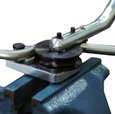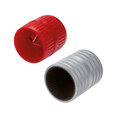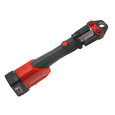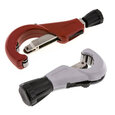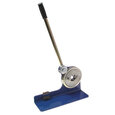Learn How To Cut PVC & Buy a PVC Pipe Cutter
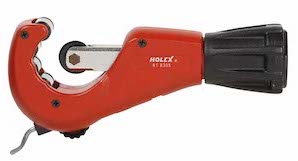
Figure 1: A C-shaped PVC pipe cutter.
Cutting PVC pipe correctly for use in a plumbing installation will help prevent leakage in the future. A PVC pipe cutter, also known as a tube cutter, is an excellent tool to get this job done. There are three typical designs for PVC pipe cutters: shears pipe cutter, ratchet pipe cutter, and C-shaped pipe cutter. This article looks closely at PVC pipe cutters, their alternatives, and how to properly cut PVC, ABS, and PEX pipes.
Table of contents
- What is PVC pipe?
- What is a PVC pipe cutter?
- How to cut PVC pipe without a PVC pipe cutter
- How to cut ABS pipe
- How to cut PEX pipe
- FAQs
Check out our selection of pipe and tube processing tools!
What is PVC pipe?
PVC (polyvinyl chloride) pipes are safe, cost-effective, and environmentally friendly. For this reason, PVC pipes are a common choice for several applications. For example:
- Water plumbing: PVC pipes are ideal for water plumbing systems because they are long-lasting. PVC pipe manufacturers follow strict regulations to ensure the pipes will be safe for transporting drinking water.
- Agriculture: Almost every aspect of water transportation in agriculture uses PVC pipes, including sprinklers, wells, and pesticide spraying.
- Conduit: PVC is a popular conduit choice for protecting cables and wires.
- Fittings: Due to its durability and flexibility, PVC has become a popular material for fittings, such as PVC ball valves. This fact has only increased the usage of PVC pipes in liquid transportation systems.
Cutting vs bending PVC pipe
An advantaget for bending a pipe instead of cutting it is that bending a pipe can change the system’s flow direction without needing a fitting (e.g., an elbow). Each additional fitting increases the chance of leakage in the system. However, bending PVC pipes does not come without its disadvantages.
Most PVC pipe bending methods require initial heating of the pipe. Suppose there is a mistake and the PVC pipe overheats. In that case, the surface of the pipe can overstretch and weaken significantly, ruining the pipe. Also, efficient heating of a PVC pipe requires special or unconventional tools, such as a heat gun or boiling water.
On the other hand, cutting a PVC pipe can be as simple as using a PVC pipe cutter or hacksaw. Then, the cut end adheres to a fitting, completing the task. Therefore, cutting PVC pipe with the right tool and know-how is simpler and more efficient than bending it.
What is a PVC pipe cutter?
A PVC pipe cutter is a specialized manual tool that quickly cuts through PVC pipes. There are three typical designs for PVC pipe cutters: shears pipe cutter, ratchet pipe cutter, and C-shaped pipe cutter.
Shears PVC pipe cutter
As seen in Figure 2, a shears PVC pipe cutter gets its name because it looks similar to a pair of shears. Most shears PVC pipe cutters can cut pipes ranging from 1.3 - 2.5 cm (0.5 - 1 in). Some larger designs can cut up to 5 cm (2 in), but doing so requires a great deal of strength and quickly becomes infeasible.
The operation of the shears PVC pipe cutter is simple. The user, after putting on proper PPE (e.g., gloves and safety glasses):
- Secures the PVC pipe in a clamp
- Puts the head of the pipe cutter around the pipe
- Squeeze the cutter’s handles until the cut is complete.
A significant disadvantage of using a shears PVC pipe cutter is the strain on the hand that multiple cuts can create. Therefore, while being the least expensive, this type of PVC pipe cutter is not the most popular.
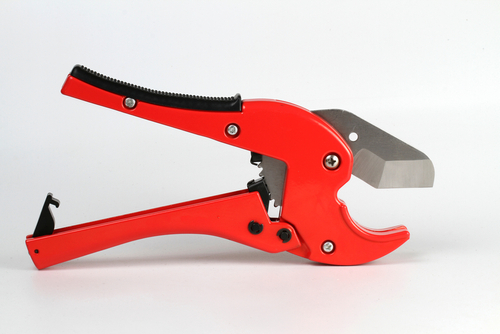
Figure 2: Shears PVC pipe cutter.
Ratchet PVC pipe cutter
A ratchet PVC pipe cutter looks and operates a lot like a shears PVC pipe cutter. The key difference, however, is this pipe cutter’s ratcheting ability. With each squeeze of the handle, the pipe cutter ratchets to hold its position until the next squeeze. This functionality takes a lot of pressure off the user’s hand during cutting.
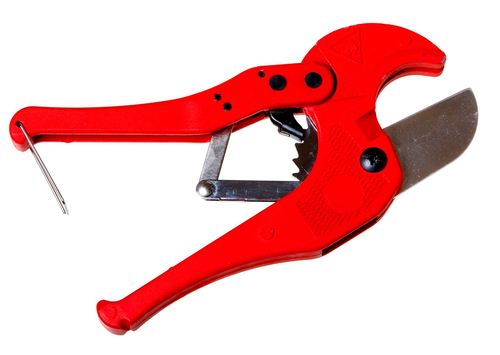
Figure 3: A ratchet PVC pipe cutter.
C-shaped PVC pipe cutter
A C-shaped PVC pipe cutter (Figure 1) looks and functions like copper and steel pipe cutters. However, the PVC pipe cutter’s cutting wheel is made of stainless steel rather than hardened steel. The C-shaped PVC pipe cutter does not put undue strain on the user’s hand, giving it an advantage over the squeeze action cutters discussed above. However, due to the cutter’s operation principle and design, the C-shaped cutter cannot fit in as many spaces as the other types of PVC pipe cutters.
To use a C-shaped PVC pipe cutter:
- Put the C-shaped head of the cutter around the PVC pipe.
- Turn the tightening knob until the cutting wheel comes into contact with the PVC pipe’s surface.
- Turn the pipe cutter around the pipe one or two times.
- Turn the tightening knob to push the cutting wheel further towards the pipe.
- Continue this turning and tightening procedure until the PVC pipe cut is complete.
After cutting PVC pipe
No matter which tool cuts the PVC pipe, burrs will be left on the edge of the cut pipe. Always use a deburring tool or sandpaper to smoothen the edge. If burrs remain on the edge of the cut when the PVC pipe is connected to a fitting, future leakage is very likely.
How to cut PVC pipe without a PVC pipe cutter
Chop saws (Figure 4) and hacksaws are popular alternatives to a PVC pipe cutter. The first cuts through PVC pipe effortlessly, and the second is a tool that finds its home in nearly every garage or toolbox.
Using a chop saw to cut PVC pipe
The common conception is that a chop saw and a miter saw are the same tools. However, chop saws can only cut at perfect 90° angles, whereas miter saws can also cut at other angles. Chop saws exceed at cutting through PVC pipes with 7.6 cm (3 in) diameters or less. However, larger diameter pipes can still be cut, depending on the diameter of the chop saw’s blade. If the cut does not go entirely through the PVC pipe, finish cutting with a hacksaw. This offers a cleaner cut than rotating the PVC pipe to cut into the uncut side.
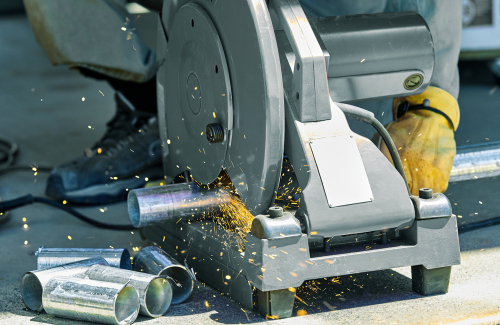
Figure 4: A chop saw cutting through galvanized steel.
Using a hacksaw to cut PVC pipe
Of all the tools discussed in this article, hacksaws require the most time and effort to successfully cut through PVC pipe. Start the process by ensuring that the hacksaw’s blade has a small TPI (teeth-per-inch), 14 TPI at the maximum. Any higher, the chance of PVC shavings becoming clogged between the blade’s teeth increases. This reduces the effectiveness of the blade and speeds up its eventual uselessness. Learn more about selecting the right hacksaw blade for a job by reading our hacksaw blade selection article.
It is unlikely to get a good cut in already installed PVC pipes using a hacksaw because the tool causes a great deal of vibration. This tool works best cutting through disconnected PVC pipes. Follow these steps to best ensure a straight cut:
- Secure the PVC pipe in a clamp to provide stability.
- Wrap a piece of paper around the pipe near the end that will be cut.
- Ensure the straight edge of the paper lines up with where the cut will take place.
- Use a pencil or marker and the paper as a “ruler” to mark around the pipe the cut location.
- Remove the paper and install a hose clamp on the inside of the marked line.
- Using the hose clamp as a guide, begin slowly cutting to create a groove in the pipe’s surface.
- Once the groove is deep enough to hold the hacksaw’s blade, begin cutting faster until the cut is finished.
Using a copper pipe cutter to cut through PVC pipe
In a pinch, a copper pipe cutter can cut through PVC pipe. However, using the copper pipe cutter to cut anything except copper will quickly dull the cutting blade.
How to cut ABS pipe
PVC pipe cutters do not work well on ABS pipe because these pipes are too brittle. Like PVC pipes, copper pipe cutters can cut through ABS pipe. A hacksaw with an 18 TPI blade works best for this job.
How to cut PEX pipe
Unlike ABS pipe, PEX pipe can be cut with a PVC pipe cutter. In fact, PEX pipe cutters are available but these are identical to PVC pipe cutters, just with a different name. Learn how compression fittings and PEX work well together.
FAQs
What is the best tool to cut PVC pipe?
A PVC pipe cutter is the best tool for cutting PVC pipe. It is relatively effortless to use and provides the cleanest cut.
What is the easiest way to cut PVC at home?
Without specialized tools like PVC pipe cutters, the best way to cut PVC at home is likely the hacksaw in the toolbox. Ensure the hacksaw’s blade is 14 TPI or lower.




